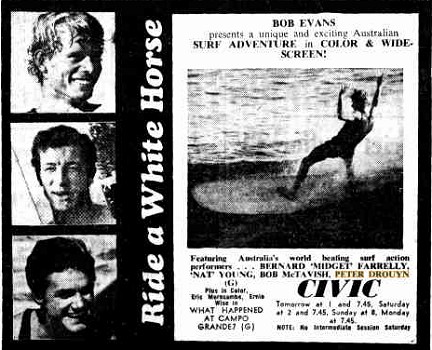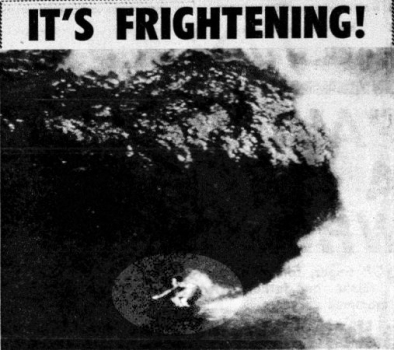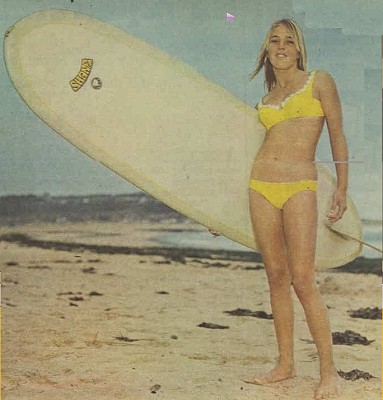
surfresearch.com.au
newspapers : 1968
newspapers : 1968
| home | catalogue | history | references | appendix |
 |
surfresearch.com.au
newspapers : 1968 |
|
|
|
|
|
| The Canberra Times 18 January 1968, page 23. Ride
a White Horse
BOB EVANS
presents a unique and exciting Australian
SURF ADVENTURE in COLOR & WIDE SCREEN!
Featuring Australia's world beating surf action performers . . . BERNARD 'MIDGET' FARRELLY, 'NAT YOUNG, BOB McTAVISH, PETER DROUYN (G.) Plus in Color, Eric Morecambe, Ernie Wise in WHAT HAPPENED AT CAMPO GRANDE? (G) Tomorrow at 1 and 7.45, Saturday at 2 and 7.45, Sunday at 8, Monday at 7.45. NOTE: No Intermediate Session Saturday. Trove 1968 'Advertising', The Canberra Times (ACT : 1926 - 1995), 18 January, p. 23. , viewed 23 Mar 2019, http://nla.gov.au/nla.news-article106987288 |
 |
|
ECHOES FROM HAWAII
By Bob Evans LAST echoes of the Hawaii 1968 scene are still reaching me. Bob McTavish has taken off for California with George Greenough to check out the beautiful coastline around Greenough's house at Santa Barbara. Bob will be one of the very few surfers fortunate enough to tour the unknown offshore islands with Greenough, the only guy who has the clues on those barren, mystical, magical locations. I spent some time with Tim Murdoch, of Auckland, in Hawaii. Tim writes that he just spent a week on the Island ot Kaui, nearby to Joey Cabell's home at Hanelei Bay. Renowned as the longest surf in the islands and also the prettiest, Hanelei performed at sizes between 3ft. and 8ft., with swell moving across the bay for a distance of 800 yards. Kaui was lush
and green and, though you may not be aware, is the
wettest spot on earth.
One day last week it rained six Inches in one hour. It is not unusual for a recording of 600 inches a year. |
 Peter Drouyn, Honolula
Bay, Maui, December 1967.
- riding Wayne Parkes' 9ft 3in Atlas-Woods (NZ) "stubby." Photograph: Bob Evans (digitally adjusted). The Sunday Telegraph, January 21 1968, page 70. |
| The Australian Women's Weekly
Wednesday 16 October 1968, page 3. At 15, Judy is a champion board-rider ... A GIRL WHO RULES THE WAVES
By MARGARET ANN KANDAL SIX years ago a cult swept Australia. It brought with it new jargon for the teenagers' already revolutionary vocabulary-words such as "gas," "king," "noah," "gremlin," and "femlin." New signs, appeared on beaches showing restricted areas for the cult. Songs and dances were dedicated to it. And most probably sales of lemons and bleaches went up because of it. Six years ago saw the boom of surfboard-riding. Young people no longer went to the closest beach for a dip or a swim. They followed the sun and went where the best waves were. But though board-riding is gaining immense popularity it is still not recognised as a national sport, despite the fact that Australia has provided two of the three world champions to date. Judy Trim knows just how hard it is to get financial support, and she's the Australian Women's Open Surf- board Champion! For months she has been seeking sponsorship so she can enter the 1968 international championships in Puerto Rico from November 6-14. |
 JUDY TRIM at Dee Why beach, N.S.W.,
with her board. She's been seeking sponsorship to compete in the 1968 international championships overseas. Pictures by staff photographer Keith Barlow [Not reproduced] CHAMPION Judy with her trophies for both the N.S.W. and National board championships. |
Unfortunately she has come good in a bad
year,
because the financial support usually given to sport by companies has been
directed
to the Olympic appeal.
Then again, she's a female
board
rider.
|
|
|
|
|

| home | catalogue | history | references | appendix |